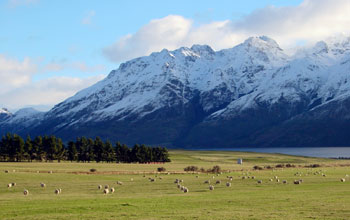Multimedia Gallery
Sheep on South Island, NZ
Sheep on South Island, NZ
Sheep on South Island, New Zealand. New Zealand has 45 million sheep and produces the finest wool in the world. It is second only to Australia in the amount of wool produced annually. The sheep actually outnumber the country's human population by more than 11 to one.
British colonists first successfully introduced sheep to New Zealand in the early 1800s. Today, there are six main sheep breeds and about 30 breeds total. Farmers keep breeds that best suit their type of farmland and climate. The Merino, for instance, is favored in the alpine grasslands of the South Island's Southern Alps. Half-breeds and Corriedales are bred on the foothills and plains east of the Alps. Romney's Coopworths and Perendales are typical of the 'crossbred' breeds used for meat and wool production. (Date of Image: May 2001)
Credit: Photo © Christyne L. Scofield
Special Restrictions: For nonprofit use only. Any public use other than by the National Science Foundation must obtain permission first from photographer, Christyne L. Scofield via email at cscofiel@nsf.gov. Please include credit when using image.
Images and other media in the National Science Foundation Multimedia Gallery are available for use in print and electronic material by NSF employees, members of the media, university staff, teachers and the general public. All media in the gallery are intended for personal, educational and nonprofit/non-commercial use only.
Images credited to the National Science Foundation, a federal agency, are in the public domain. The images were created by employees of the United States Government as part of their official duties or prepared by contractors as "works for hire" for NSF. You may freely use NSF-credited images and, at your discretion, credit NSF with a "Courtesy: National Science Foundation" notation.
Additional information about general usage can be found in Conditions.
Also Available:
Download the high-resolution JPG version of the image. (1.4 MB)
Use your mouse to right-click (Mac users may need to Ctrl-click) the link above and choose the option that will save the file or target to your computer.

